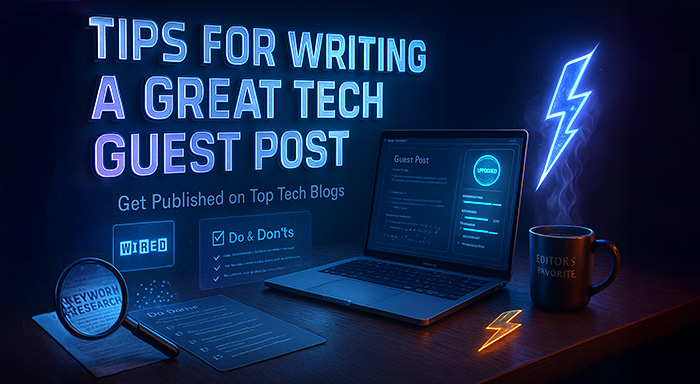Introduction
In the intensely competitive and vibrant world of technology, Writing Tech Guest Post content has become a tremendously valuable form of communication. It closes the bridge between communities and creators. Irrespective whether you are an aspiring engineer, seasoned developer, or technical writer, guest posting proves to be a great way to demonstrate your expertise, widen your audience base, and provide meaningful contributions to the ecosystem. A well-crafted tech guest post not only aids you in developing your professional brand but also offers great value to industry professionals.
In this in-depth guide, you will get 10 detailed tips on creating a convincing technical guest post that not only engages readers, but also demonstrates your expertise, aligns with industry standards, and improves your chances of getting published online.
What Is a Tech Guest Post?
A tech guest post can be described as an article that someone contributes from outside to a website. Just like any other guest, its purpose is to boost backline profile, improve audience base, and enhance credibility in the market. Contrary to general guest posts which focus on opinion-driven content, lifestyle, or other non-technical topics, tech guest posts especially focus on technology, actionable content, and specialized knowledge. It is important for the guest post writers to demonstrate their subject knowledge and expertise on the topic on which they are writing. Essentially, tech guest posts can include the following types of content:
- Walkthroughs and tutorials.
- Deep dive into core concepts of programming.
- Comprehensive case studies on frameworks or tools.
- Cloud computing, DevOps, Internet of Things, or AI implementations
- Tips for debugging and strategies for performance optimization.
Creating a guest post for a technology website needs more skill sets than just proficiency in writing. It requires technical accuracy, subject expertise, and the capability to communicate complex technical concepts in a comprehensive, yet simple way.
What Is the Importance of Tech Guest Posts?
Before we delve deep into how to write a top-quality guest post, it is important to understand why guest posting on tech blog is so significant:
- Building Authority:
Publishing high-quality and well-researched content on technology write for us websites can improve your credibility as a tech writer. For brands, it can be a great way to demonstrate expertise.
- Opportunities for Networking:
Engaging with fellow contributors, editors, and readers can open the door to better career growth and collaboration.
- Backlinks and SEO:
Your tech guest posts can also include relevant backlinks to your portfolio or website, enhancing your overall search visibility.
- Contribution to Community
Sharing best practices or expert solutions aids other developers in overcoming important tech challenges. It also establishes goodwill and improves your rapport with industry leaders.
Understanding these advantages can aid you in creating best-quality guest posts that can not only serve your objectives but also help the tech community.
Main Tips for Creating an Impressive Tech Guest Post
1. Deeply Understand the Blog Guidelines and Target Audience
Before starting to write, invest a few minutes going through the website guest post and submission guidelines. Each platform targets separate demographics and audiences. Essentially, you must figure out whether you are creating content for system administrators, front-end developers, or machine learning engineers, etc.
Main Points You Need to Focus On:
- What are the recent topics that have been posted on the website?
- What is the tone of the content, whether it is formal, casual, or academic?
- Is the blog friendly for beginners or relevant for the experts?
- What is the average structure and post length of the content posted on the website?
Many websites have separate pages for style guides and quality guidelines. Aligning with these expectations enhances the possibilities of your post to be approved.
2. Choose a Particular Niche
If you focus on a wide range of topics, then the guest posts are likely to lack depth and focus. In order to make your guest posts more compelling and effective, it is important to focus on one niche and build your expertise around that. Choose a main idea or problem and focus on creating a blog centered around explaining or solving the problem in detail.
A few examples of niche-centric tech topics:
- “What Is the Role of IoT in Healthcare?”
- “Why Businesses Are Investing in AI Development Companies?”
- “Julius AI- No-code Platform for Instant Data Analysis, Visualization, and Insights”
If you narrow your focus on a few topics, then you will be able to substantially boost your expertise over time. Thus, you will create more in-depth and valuable content. This is especially true if you wish to create content with code, real-world examples, and benchmarks.
3. Create Content to Offer Clarity Not to Increase Complexity
No matter how proficient your content looks, if there is no clarity, your audience might get confused. This will greatly increase your bounce rate, which is not good as far as SEO performance is concerned. Thus, you must avoid overly complex sentences, unnecessary difficult words, or assumptions regarding the reader’s technical knowledge.
To improve the level of clarity:
- You must use an active voice.
- If you are using acronyms, define them the first time you use them.
- Avoid long paragraphs or explanations. Instead, you can utilize numbered steps or bullet points.
- Try to create shorter paragraphs. You can use a maximum of up to 2-4 sentences.
A clear and easy-to-read article does not actually decrease your expertise. It makes it more accessible. User-friendly content becomes especially useful if you are planning to submit content to a tech website or a larger platform that caters to a wider technical readership.
4. Leverage a Clear Structure
Well-structured content becomes a lot easier for the reader to understand. Furthermore, even editors prefer content that has a clear structure and is easier to read.
A general structure you can follow:
- Introduction – This is the starting portion of your guest post and details the problem statement or goal of the blog.
- Context – In this section, you can provide all the prerequisites such as tools and versions that users need to be familiar with.
- Body of the Content – This includes your analysis as well as the step-by-step explanations if you have included any.
- Conclusion – In the conclusion section, you can summarize the main takeaways.
To separate sections and create a structured hierarchy in the content, you can include h1, h2, and h3 heading tags. Any blog post, irrespective of the niche, must contain an introduction and a conclusion.
5. Include Working Examples as Well as Real Codes
One of the significant aspects of a technical guest post is the code. However, it is important to include codes that are well tested, explained in the blog, and easy to understand.
Right practices:
- Utilize syntax highlighting
- Don’t include large blocks of code in your blog. Instead, you can focus on breaking the large blocks into smaller chunks of code.
- You can even offer comments in the code to make the logic clearer.
- If possible, include a link to the GitHub repository as well.
- Don’t focus on using dummy codes just for the sake of including codes. Real-life use cases and code snippets create maximum impact.
If your tech guest post also includes some level of configuration (like nginx.conf or compose.yml), it is advisable to include them either in full or partial segments.
6. Provide References, Sources, and Data to Support Your Arguments
When it comes to SEO and guest posts, credibility is everything. Whenever you are making a claim related to security, performance, or tool comparisons, it is recommended to support it with references, data, and resources.
Credible types of sources you can include in your content:
- Official documentation e.g., Kubernetes.io, Python.org.
- GitHub changelogs or repositories.
- References to reputable websites.
- Reddit threads or Stack Overflow (with caution)
Avoid using personal blogs to support your content unless they are industry-respected or well-known. It is critical to embed hyperlink every reference with relevant anchor texts for greater transparency.
7. Include Diagrams, Flowcharts, and Visuals
Visuals are a great way to enhance the appeal of your guest post. Furthermore, they can also be used to simplify complex topics. Essentially, you can use it to turn a nuanced topic into an easy-to-understand idea.
Types of Visual Content You Can Include in Tech Guest Post:
- Infographics
- Flowcharts
- Performance graphs
- Screenshots of the tools and GUI
- Architecture diagrams
- Terminal outputs
Furthermore, platforms such as Lucidechart, Excalidraw, and Mermaid.js can aid you in creating elegant visuals that can enhance the quality and appeal of your guest post.
8. Focus on SEO, But Avoid Over-obsessing
In order to gain visibility into your guest post, using SEO techniques is crucial. However, you must avoid over-optimizing your content under all circumstances. You need to use standard and authentic SEO techniques so that search engines can rank. Furthermore, with new Google updates in July 2025, the focus has shifted from SEO-friendliness to helpful content.
SEO Strategies You Can Use to Optimize Your Content:
- Try to include keywords in strategic places such as headings, intro, conclusion, meta description, etc.
- Focus on the natural placement of your focus keyword. For example, if your keyword is contribute to our tech blog, then it can come 4-5 times in the content, but all placements must be natural.
- Concentrate on creating an effective Meta Description (160 characters or less)
- Focus on creating descriptive alt text for all your images.
- Create relevant subheadings.
- Avoid over-stuffing your keywords. Google is quite strict about it and can even penalize it.
Emphasize on relevance, helpfulness, and not repetition. Google gives priority to the content that responds to user intent and not keyword count.
9. Edit, Test, and Refine
Ever since AI entered the digital marketing space, the way writers edit has become more important than actual writing. The level of editing can determine whether the content is humanized. Moreover, closely editing the content minimizes possibilities of broken codes, typos, or formatting errors. It also indicates how much the writer cares about small details.
Tips for Editing:
- If you have used AI, don’t forget to humanize the content.
- There might be a few grammatical issues. So, you can use Hemmingway or Grammarly to fix it.
- Reread the content to ascertain flow, logic, and clarity.
- Re-run all the snippets of the code to check the accuracy of the codes.
- Verify all the hyperlinks and make sure they are embedded in relevant anchor texts.
- Utilize consistent formatting (headers, spacing, or bolding)
It is advisable to leave the post for at least 24 hours before sitting down to do the final review. Reviewing your final draft with a fresh perspective can help you spot details and improvements you might have missed earlier.
10. Create an Effective Author Bio
Keep in mind that your “Author Bio” is like your digital handshake. Not only does it develop credibility, but it also allows you to re-establish connections with readers.
What You Can Include:
- Current role as well as your full name. (e.g., “Peter Nielson, DevOps Engineer at XYZ Ltd.”)
- You can also mention all the tools that you are familiar with.
- Relevant links which can direct readers to your LinkedIn, GitHub, or personal blog.
Different websites have different guidelines for backlinks. Thus, you can go through their guidelines well before including any backlinks. It is important to maintain professionalism throughout your guest post submission.
Conclusion
Creating an in-depth technical guest post is not just about showcasing what you know. It is about presenting facts and expertise in a way that connects with others. From selecting the correct topic to creating the right content structure, every step plays a crucial role in creating an effective tech guest post. Irrespective of whether your objective is getting recognition, giving it back to the community, or building an effective backlink profile, the above-mentioned tips can guide you in the correct direction.
If you have any plans to contribute to our tech blog, you can use this framework as the starting point to begin your process. However, we have detailed guidelines on our website which you can go through.
While creating tech guest posts, the focus must be on educating, engaging, and inspiring your readers with helpful content that can serve you for a long time.



